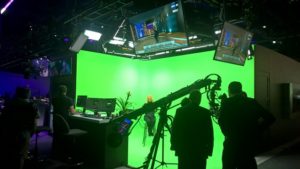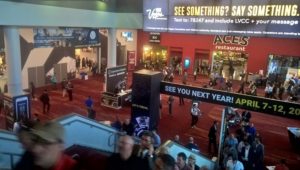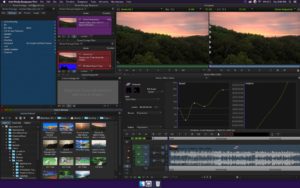
One can think of last week’s NAB as simply one of the largest conventions in Vegas — along with the not-unrelated CES. CES, in January, is a gathering to show what kinds of screens consumers will desire, or be led to desire, to both hold and let themselves be beheld.
NAB then, is the gathering where the content for those screens, and the ways to make, stream, and broadcast, are all discussed.
Yet it’s also possible to think of NAB in terms of the old tale of the blind men and the elephant: The way we experienced the convention for this story was be different than the way the young filmmaker, just out of USC and chatting at a beer-and-pizza gathering for camera folk in a nearby industrial park. His approach echoed what an editor friend told us after she’d read Part I of our coverage, saying that if posts from her friends and colleagues were any indication, “NAB Vegas is the new Sundance /SD Comic Con,” something we were aiming to articulate last time out.
But then again, if the same attraction can bring both budding film directors and FCC heads together (newly installed FCC head Ajit Pai was there with vague pronouncements about “getting government out of the way” of broadcasters, before winging back to Washington to announce a rollback of Net Neutrality rules to make the whole enterprise far less equitable at the user end), this was still a different NAB than the portly and bemused-looking Swedish radio engineers — standing next to us on the crowded monorail snaking its way down the strip– were going to have.
The first thought was that those Nordic engineers were having the most retro/authentic type of “NAB experience” after all, as they scouted for terrestrial broadcast equipment. But it’s likely they were just as interested in getting (their probably government subsidized) content streamed, as well.
Though if, per Hemingway, we are all of us “islands in the stream” now, other themes that emerged on our non-Swedish Engineer tour of NAB seemed to fall into the VR and “collaboration” categories.
This last was evident when we found ourselves in back-to-back meetings with folks from Foundry, the UK’s legendary maker of Nuke compositing software, and Avid, of digital editing fame. At one time, these would have been distinct steps in filmmaking. “Special effects” might have meant matte paintings or Ray Harryhausen ball-and-socket assemblies in the arms of cyclopes, and editing would have been a mechanical process involving the literal “cutting’ of film.

Aside from the fact both of these have been software-driven processes for some time, both companies are also preaching a kind of “open source” approach to collaborative tools, that cut across what might have been the former “verticals” of the production process, and now are about shuttling information around, and across, those, formerly separate aspects.
Called “Elara,” Foundry’s cloud-based service for “post production” (though really, if you’re editing and pre and post-vising your digital dailies, is a dividing line anymore?), lets “studios access everything they need via their web browser,” including Foundry’s own software, other applications, and even a scalability that runs the gamut from the 360 degree camera that Facebook has been pushing since its own F8 conference (which connects to your phone and lets you stream and webcast away!), all the way to VR-level rendering.
“Both ends of the scale,” as Foundry co-founder Simon Robinson told us, encompassing data from new cameras and new architecture, while still hanging on to your current laptop.
And hanging onto laptops, rather than having to “re-fleet” them every 10 months, was another subtext of the show. We spoke to Avid’s Matt Feury, their director of pro video marketing, to talk about all the, well, “non-pro” access they’re offering.
Which may be smart for all those putative future pros: There’s a free version of Media Composer, which still allows you to “do 4k over the phone.” The number of different tracks to edit from is limited in the free version, but it allows “easy sharing, and easy publishing to popular social media channels including YouTube, Vimeo and Facebook,” as Avid’s release has it.
Actually called “Media Composer | First,” the idea is that it will be a post-productionist’s “first” taste of Avid fresh out of film school or media studies, and that she will eventually become one of those pros using the cloud-expanded “Avid Everywhere,” part of a partnership with Microsoft, no less, via Azure, so that not only can workflow be managed — through those laptops again! — via the cloud (which in the end, really means someone else’s servers, but we digress), but allow companies to “create, distribute, and monetize their content using the deployment type that works best for them.”
Except will our Media Composer | First user need to do that if her content can already be “everywhere” in the YouTube/Vimeo/Facebook (they with the Foundry-supported camera!) sense?
Everything is everywhere now, according to the NAB trend lines, or as Lauryn Hill sang, “everything is everything.”
Even the officially created, franchisable “things” — like those tent-pole movies, perhaps soon to be done on those networked, rendering laptops — are part of the great interconnectedness of the “everything,” even if they’re only providing the semiotics, or the blueprints (as byproducts of the storytelling) by which the future gadgets at NAB are devised.

By which we mean “FUI.” That stands for “Fictional User Interface,” and generally means the kind of tech used in films — like the floating touch-screens in Minority Report, pretty much anything at Avengers headquarters, the cell-phone inspiring communicators of Star Trek, et al — that characters in stories use, but that you might be using soon enough to order a self-piloting car, or a replicant for companionship.
And if you Google the term, you’ll find that the “F” in “FUI” can sometimes mean “Fantasy” or yes, “Future.” The “UI” stays the same.
The Maxon company, known for 3D modeling, rendering, and other FX-y skills, hosted a lunch on UI’s and FUI’s during NAB, that also talked about VR and AR — which, speaking of futures, is probably the “R” that will be ubiquitous first, i.e., “Augmented Reality.” That arguably describes all of our lives right now, except in this case, AR means some kind of artifact — entertainment or commercial based, usually (though there may well be medical and military applications) — added to your “real” environment. Such as it is.
Maxon assembled a slew of various UI designers, 3D modelers, etc., to hold forth during the lunch, where one of the upshots was, as their own “chief creative,” John LePore asserted, that “movies normalize a design aesthetic.”
Which means that NAB, really like Vegas itself, is ultimately a showcase of products emanating from the collective id.
Which is what makes it so captivating.
Though in spite of being at NAB in a city that itself is augmented/virtual reality, we did have a compelling VR demo from Digital Domain (as everyone continues to move through, and around, the “VFX space.”)
We sat down for one of their NBA VR experiences — should that be in quotes? — that DD is working on with the league. And while putting on the goggles instantly whisked us away from the convention floor, once we were in b-ball talk show mode, it truly felt like we were there in the studio with the host and the NBA greats holding forth. In this case, we even noticed the bottoms of James Worthy’s shoes.
Of course, it still felt like we were in an avatar-ish, videogame version of that talk show — but we were still there in the room. There are partnerships with DreamWorks and Universal in the works, and DD is also developing its own “episodic content,” to provide the “must see TV” aspect to VR.
Which may mean some of the old models in getting people to notice content — and hopefully pay for it — may still apply: Tell a really good story.
But if NAB tells us anything, it’s that everything about the users and their interfaces, is still in flux. There will be collaborations, screens, eyeballs, content, makers, all the rest. But as with the roulette wheels and slot machines in the host city, the tumblers haven’t settled on a verdict yet.





